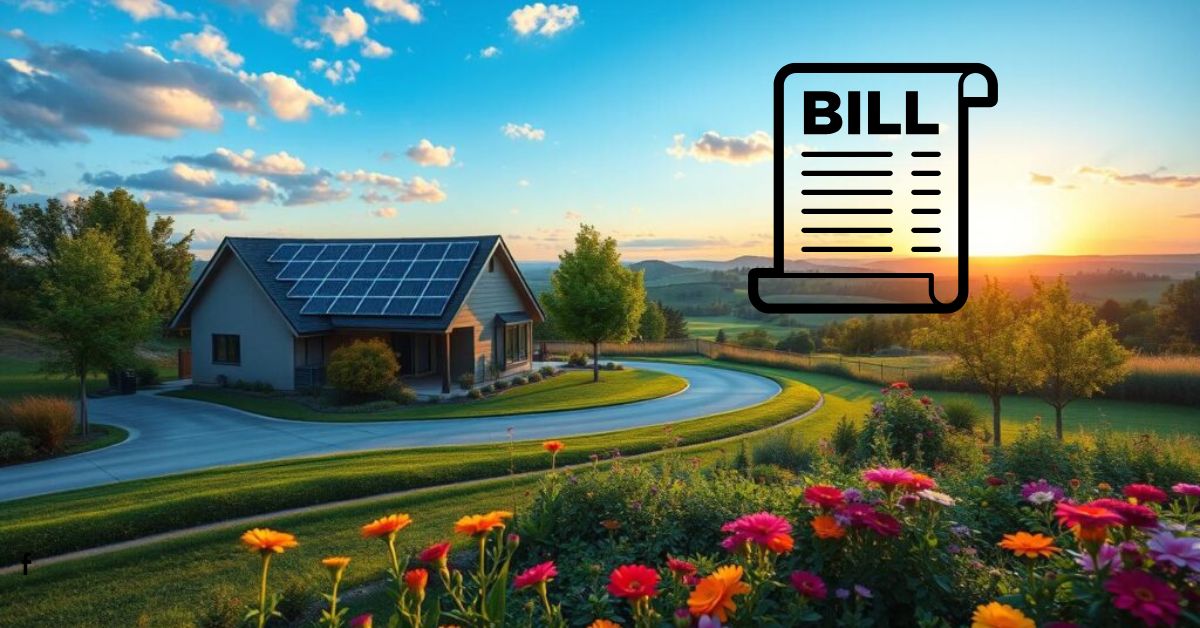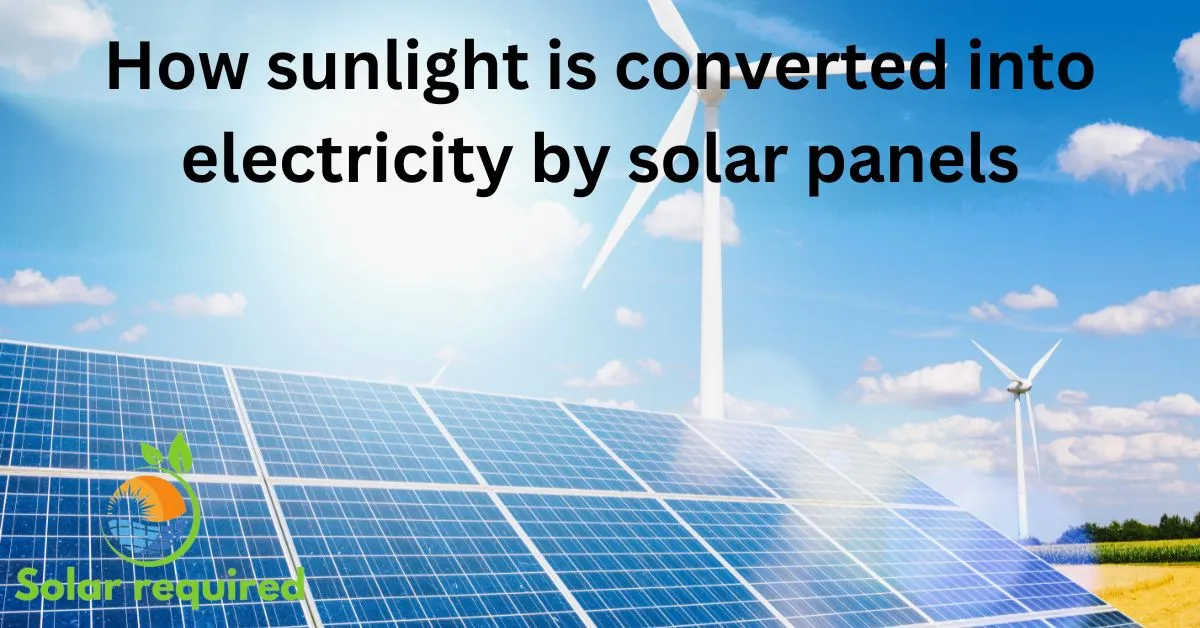Homeowners are now looking into solar power as renewable energy grows. Figuring out how much you can save by switching to solar panels is key. This guide will help you understand if solar energy is worth it for your home.
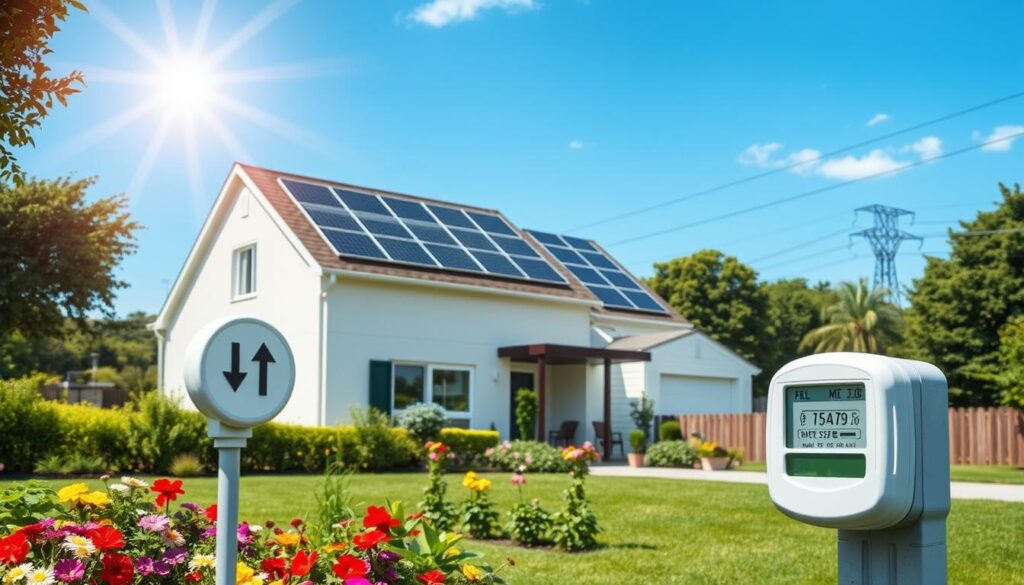
Key Takeaways
- Understand your current electricity consumption and costs to establish a baseline for comparison.
- Explore the initial investment and available incentives for solar panel installation.
- Calculate the long-term financial benefits of transitioning to solar energy.
- Assess factors that affect solar panel performance and output to maximize your savings.
- Leverage net metering and grid connection benefits to optimize your solar energy savings.
Understanding Your Current Electricity Consumption and Costs
Getting to know your utility bills is key to cutting down on costs and boosting energy efficiency. By diving into your electricity cost analysis, you can make smart choices about switching to solar power. This move can lead to big savings for you.
How to Read and Analyze Your Utility Bills
Your utility bills hold lots of useful info. Look closely at your total energy consumption, peak usage periods, and cost per kilowatt-hour. Knowing these details can give you a clear picture of how you use energy. Calculate solar power.
Tracking Peak Usage Periods and Rate Variations
- Find out when you use the most electricity.
- Check for time-of-use or demand-based rates that change with your usage.
- Notice how your energy use changes with the seasons and rate changes.
Identifying Energy Consumption Patterns
Study your past utility bills to spot trends in your energy use. Look for big increases in certain months or changes in your usual use. This can show you where to apply energy efficiency efforts to lower your utility bill.
“Understanding your current electricity consumption and costs is the foundation for making informed decisions about transitioning to solar power and maximizing your potential savings.”
The Basics of Solar Panel System Investment
Getting a residential solar panel system is a big but rewarding step for homeowners. It’s about using renewable energy. Knowing the basics of solar panel installation is key to making a smart choice that fits your energy needs and budget.
Solar panels are at the heart of a solar energy system. They turn sunlight into electricity, a green alternative to regular power. The number and size of panels needed depend on your home’s energy use, roof space, and how much power you want.
A solar energy system also includes other important parts. An inverter changes the direct current (DC) from panels to alternating current (AC) for home use. A mounting system holds the panels on your roof, making sure they get enough sun for best energy production.
When thinking about residential solar installation, you need to look at your current solar panel installation needs and budget. This means checking your monthly electricity use, knowing the system’s upfront costs, and looking into renewable energy solutions and incentives to help with the initial cost.
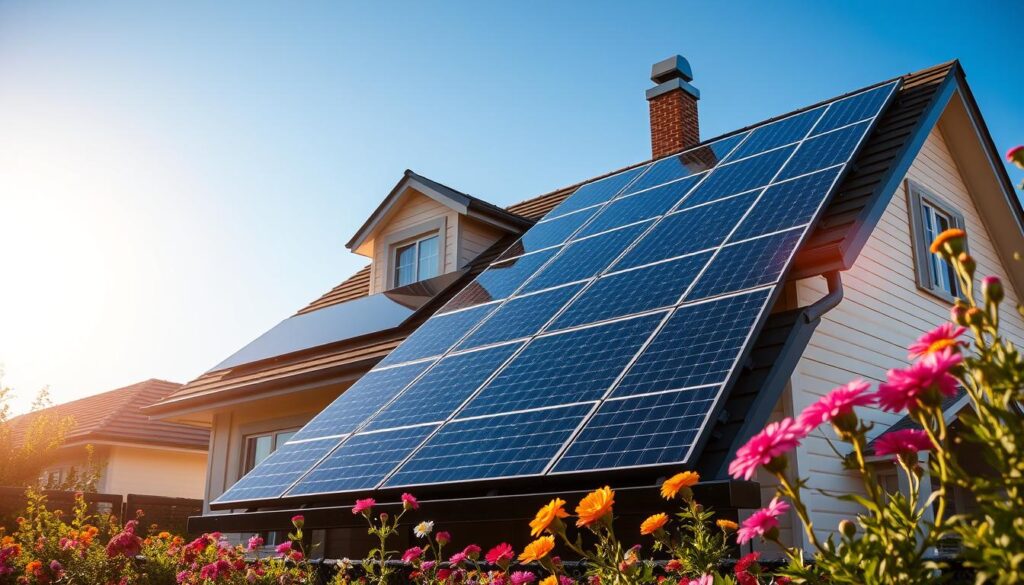
By carefully looking at these points, you can make a choice that meets your energy goals and saves money in the long run. Investing in solar panels is a smart step towards energy freedom and a greener future.
Initial Solar Installation Costs and Available Incentives
Switching to solar energy can seem pricey at first. But, knowing the right incentives can lower these costs. Let’s look at how these incentives can make solar power more affordable for homeowners.
Federal Tax Credits and State Rebates
The federal government has a tax credit called the Investment Tax Credit (ITC). It can cover up to 26% of the cost of a solar system. Many states also offer rebates, which can add up to thousands of dollars, depending on where you live.
Local Government Incentives
Local governments also help with solar installation costs. They offer property tax breaks, solar renewable energy certificates (SRECs), and cash rebates. Checking out local incentives can help homeowners save more on their renewable energy investment.
Utility Company Programs
Utility companies also have programs to encourage solar energy. These include net metering, which lets homeowners sell extra electricity, and rebates or financing. Looking into these programs can help homeowners save even more on energy cost savings.
| Incentive Type | Average Savings |
|---|---|
| Federal Tax Credit (ITC) | 26% of total system cost |
| State Rebates | $500 – $5,000 |
| Local Incentives | Varies by location |
| Utility Company Programs | Varies by utility |
By using these different incentives, homeowners can lower the initial solar installation costs. They can also enjoy long-term energy cost savings from using solar power.
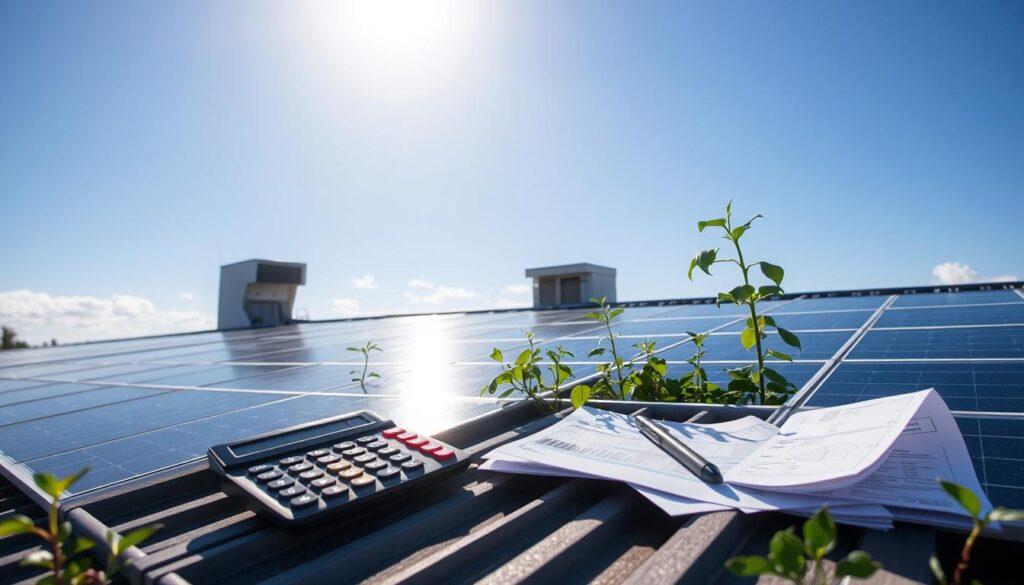
Calculate Your Potential Savings: Solar Panels vs. Electricity Bills!
Switching to solar energy can save you money. But, it’s important to know how much you can save. A solar energy savings calculator can help you figure out your savings when you switch to solar panels.
To find out your savings, you need to look at a few things:
- Your current electricity costs: Check your utility bills to see how much you spend each month and year.
- Solar panel efficiency and energy production: Think about how much energy your solar panels will make. This depends on their size, where they are, and how much sun they get.
- Incentives and rebates: Look into government incentives and your utility company’s programs. These can help you save even more on your bills.
Put these details into a solar energy savings calculator to see how much you could save. This will help you decide if solar panels are a good choice for you.
| Factor | Consideration |
|---|---|
| Current Electricity Costs | $150 per month on average |
| Solar Panel Efficiency | 20% conversion rate |
| Solar Energy Production | 6,000 kWh per year |
| Incentives and Rebates | 30% federal tax credit, $1,000 state rebate |
Using a solar energy savings calculator and thinking about these factors can help you estimate your savings. This way, you can make a smart choice about getting solar panels to save on your bills.
Related: 8 Powerful Features of Enphase Micro Inverters
Long-term Financial Benefits of Solar Energy
Investing in solar energy saves you money on electricity bills today. It also brings long-term financial benefits that can greatly increase your wealth. Let’s look at the main advantages of solar energy and how it can improve your financial future.
Return on Investment Timeline
The cost of installing solar panels might seem high at first. But, the long-term savings and returns make it a smart choice. Solar panels usually pay off in 8-15 years, based on your location, energy use, and incentives. After paying off, the savings are pure profit, helping you live sustainably and use green energy.
Property Value Increase
Studies show homes with solar panels sell for more money. They often get back a lot of the installation costs. This feature is a big plus when selling your home, attracting buyers who want to live sustainably and use green energy.
Energy Independence Benefits
Solar panels let you make your own electricity, reducing your need for the grid. This makes your energy costs stable and secure. It also helps the environment, making your future cleaner and more sustainable.
| Benefit | Description |
|---|---|
| Return on Investment | Typical solar panel systems have a payback period of 8-15 years, after which the energy savings are considered pure profit. |
| Property Value Increase | Homes with solar panels can command a higher resale value, often recouping a significant portion of the installation costs. |
| Energy Independence | Generating your own electricity through solar panels reduces reliance on the power grid and protects you from future rate hikes. |
“Investing in solar energy is not just about saving money on your electricity bills today, but it’s about securing a brighter, more sustainable financial future for you and your family.”
Understanding Solar Panel Performance and Output
Solar energy systems use the sun’s power. But how do solar panels turn sunlight into electricity? Let’s explore the technical side of solar panels to see how they can save homeowners money.
Solar panels soak up sunlight and turn it into direct current (DC) electricity. This happens through the photovoltaic effect. The panel’s tech, sun angle, and weather affect how well it works.
To figure out how much energy a solar system will make, we look at a few things. These include the panel’s power, sunlight, and system size. The average American home uses about 10,400 kilowatt-hours (kWh) of electricity each year. A good solar system can cover a lot of that.
| Factor | Impact on Solar Panel Performance |
|---|---|
| Panel Technology | More efficient panel designs, such as monocrystalline or bifacial solar cells, can boost energy output. |
| Sun Exposure | Optimal panel orientation and tilt angle maximize the capture of direct sunlight. |
| Weather Conditions | Cloud cover, temperature, and other environmental factors can affect solar panel efficiency. |
Knowing how solar panels work helps homeowners make smart choices. They can see the savings they might get from solar energy.
“Solar energy is the cleanest, most abundant renewable energy source available, and we have the technology to harness it on a global scale today.” – Narendra Modi, Prime Minister of India
Factors Affecting Solar Energy Production
Several key factors can influence the power of solar energy. Knowing these factors is crucial for getting the most out of your solar panels. This helps in saving energy and reducing environmental impact.
Geographic Location and Sun Exposure
Your property’s location affects the solar radiation it gets. Places closer to the equator or with less cloud cover get more sun. It’s important to check your local climate and sun patterns for the best solar panel placement.
Panel Orientation and Tilt
The way your solar panels are set up matters a lot. Panels facing true south or north get the most sunlight. Adjusting the tilt to match your location can also boost energy capture.
Weather Patterns and Seasonal Changes
Weather like clouds, rain, and temperature can change how well your panels work. Cloudy days or extreme temperatures can lower efficiency. Knowing your local weather helps you plan for changes in solar energy savings.
By considering these factors, you can make your solar panels work better. This ensures you get the most renewable energy and save on energy costs.
Net Metering and Grid Connection Benefits
Installing a residential solar panel system opens up the chance to use net metering programs. These programs let you sell extra electricity back to the grid. This way, you can lower your energy bills when your solar panels don’t meet your needs.
Being connected to the grid also means you have a backup power source. This is useful during cloudy days or at night when your panels don’t work well. It ensures you always have power, even when your solar system isn’t at its best.
Net metering and grid connection make your solar panel investment more worthwhile. They help cut down your utility bills and save you money. This means you can get back your initial costs faster and move towards being energy independent.
FAQ
What is the process for calculating potential savings when switching from traditional electricity to solar energy?
To figure out your savings, start by looking at your current electricity bills. Then, consider the costs of installing and maintaining solar panels. Don’t forget to include any incentives or rebates you might get. Our guide will show you how to do this step by step.
How can I understand my current electricity consumption and costs?
Start by analyzing your utility bills. Our guide will teach you how to read them and spot patterns. This will help you understand your energy use and costs better.
What are the basic components of a residential solar panel system?
A solar panel system for your home includes solar panels, an inverter, and a mounting system. It also has other electrical parts. Our guide explains what each part does and how they work together.
What kind of incentives and rebates are available for installing a solar panel system?
There are many incentives to help with the cost of solar panels. These include federal tax credits, state rebates, and local incentives. Our guide covers these options to help make solar energy more affordable.
How can I estimate the long-term financial benefits of switching to solar energy?
When thinking about solar energy, look at the long-term benefits. This includes the return on investment, any increase in your home’s value, and the freedom from relying on the grid. Our guide breaks down these benefits to help you see the full picture.
What factors affect the performance and output of a residential solar panel system?
Several things can change how much energy your solar panels make. These include where you live, how your panels are set up, the weather, and the seasons. Our guide explores these factors to help you understand their impact.
How does net metering work, and what are the benefits of remaining connected to the power grid?
Net metering lets you sell extra energy back to the grid, lowering your bills. Being connected to the grid also gives you a backup when solar energy is low. Our guide explains how net metering works and its benefits.
